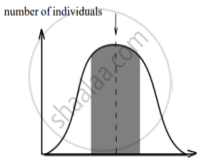Advertisements
Advertisements
Question
A population of 200 fruit flies is in Hardy Weinberg equilibrium. The frequency of the allele (a) 0.4. Calculate the following:
Frequency of the allele (A).
Solution
In Hardy Weinberg, p2 + 2pq + q2 = 1, where 'p2' is the frequency of the homozygous dominant genotype (AA), '2pq' is the frequency of the heterozygous genotype (Aa), and 'q2' is the frequency of the homozygous recessive genotype (aa).
Given:
q = 0.4
We know p + q = 1
p = 1 − q
= 1 − 0.4
= 0.6
Frequency of allele, p(A) = 1 − 0.4
= 0.6
APPEARS IN
RELATED QUESTIONS
p2 + 2pq + q2 = 1. Explain this algebraic equation on the basis of Hardy Weinberg's principle.
State Hardy-Weinberg’s principle.
How does Hardy-Weinberg’s expression (p2+2pq+q2=1) explain that genetic equilibrium is maintained in a population? List any four factors that can disturb the genetic equilibrium.
Hardy Weinberg's principle explains ______
Disturbance of Hardy - Weinberg equilibrium results in
The factor that leads to the Founder effect in a population is ______
Enumerate three most characteristic criteria for designating a Mendelian population.
At a particular locus, the frequency of allele A is 0.8, and that of allele a is 0.2. What would be the frequency of heterozygotes in a random mating population at equilibrium?
The graphs below show three types of natural selection. The shaded areas marked with arrows show the individuals in the population who are not selected. The dotted vertical lines show the statistical means.
 |
 |
 |
| character Graph A |
character Graph B |
character Graph C |
- What names are given to the types of selection shown in graphs A, B and C?
- After the selection has operated for several generations in the above populations indicated as, Graph A, B and C, graphically illustrate the probable results.
A population of 200 fruit flies is in Hardy Weinberg equilibrium. The frequency of the allele (a) 0.4. Calculate the following:
The number of homozygous dominant fruit flies.
